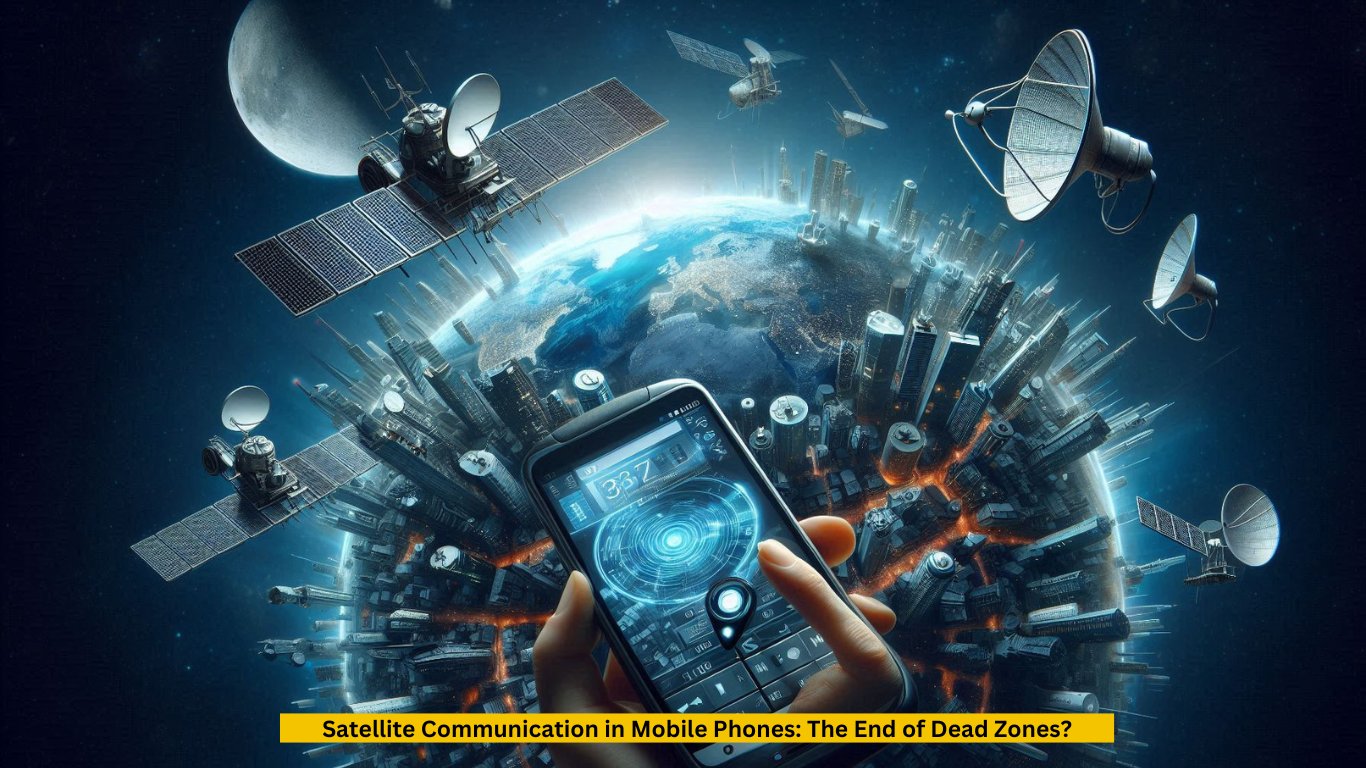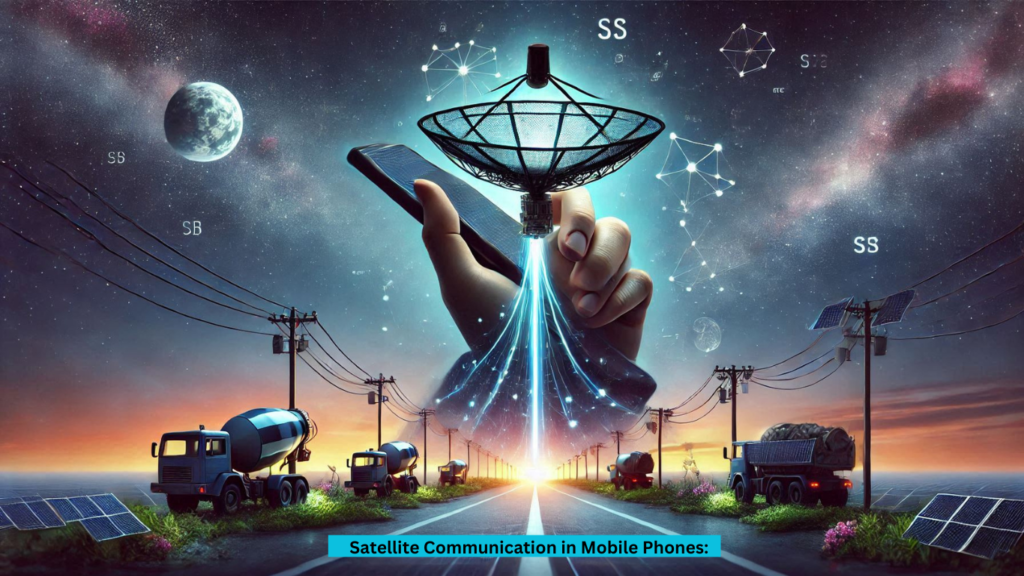Satellite Communication in Mobile Phones: The End of Dead Zones – 2025
Satellite Communication in Mobile Phones: The End of Dead Zones?
Satellite Communication in Mobile Phones: The End of Dead Zones: The advent of satellite communication in smartphones heralds a new era of connectivity. This groundbreaking technology promises to eliminate network coverage gaps, commonly referred to as “dead zones,” and pave the way for truly global mobile networks with satellites. With smartphones with satellite connectivity explained, the future of communication looks brighter than ever. Let’s delve into how this innovation works, its potential, and its implications for our daily lives.
What is Satellite Communication in Mobile Phones?
How satellite communication works in smartphones involves transmitting and receiving signals through satellites orbiting the Earth. Traditionally, this technology was limited to specialized devices like satellite phones for emergency connectivity 2025, which were bulky and expensive. However, recent advancements have miniaturized the technology, enabling integration into standard smartphones. For example, Apple Emergency SOS via satellite utilizes satellite communication to connect users in areas without cellular or Wi-Fi coverage.
Visit: Time Now USA
By bridging the gap between terrestrial and satellite-powered global internet access, this innovation aims to provide seamless connectivity, ensuring that users are never out of reach—even in the remotest locations.
The Problem of Dead Zones
Dead zones refer to areas where cellular networks are unavailable. These are common in rural, mountainous, or offshore regions where building terrestrial network infrastructure is either too costly or technically challenging. For years, these areas have posed significant challenges for travelers, residents, and emergency responders.
No dead zones mobile networks could render these dead zones obsolete. By connecting directly to orbiting satellites, affordable satellite communication smartphones can bypass terrestrial infrastructure altogether. This has profound implications, particularly in:
- Emergency Situations: In remote areas, lack of connectivity can delay critical rescue operations. Emergency communication via satellite phones ensures that emergency messages can be sent and received without delay.
- Global Travel: Adventurers and professionals who traverse remote regions often struggle with staying connected. Satellite technology for disaster preparedness offers a lifeline, enabling continuous communication regardless of location.
- Underserved Communities: Many rural and developing areas suffer from limited connectivity due to economic or logistical constraints. Benefits of satellite connectivity in rural areas could democratize access to communication, leveling the playing field for all.
How Satellite Connectivity Works in Smartphones
Smartphones equipped with satellite communication use specialized antennas and chipsets to establish a direct link with satellites. Here’s a simplified breakdown of how this technology functions:
- Signal Transmission: When a user sends a message or initiates a call, the smartphone’s satellite communication module directs the signal toward the nearest satellite.
- Satellite Relay: The satellite receives the signal and relays it to a ground station, which is connected to the broader communication network.
- Signal Delivery: The ground station routes the signal to the intended recipient—be it another satellite device or a traditional phone on a cellular network.
Modern smartphones optimize this process to minimize latency and power consumption, making the experience as seamless as possible for users.
Recent Advancements in Mobile Satellite Connectivity
The integration of satellite technology into consumer smartphones is a relatively new phenomenon, driven by innovations from major tech companies. Some notable milestones include:
- Apple Emergency SOS via Satellite: Launched in 2022, this feature enables iPhone users to send emergency messages when cellular coverage is unavailable. By simplifying satellite-based communication, Apple has set the standard for future advancements.
- Qualcomm Snapdragon Satellite for Android devices: Announced in 2023, this chipset technology brings two-way satellite messaging capabilities to Android devices, expanding access to satellite communication across a broader range of smartphones.
- Starlink for smartphones: What to expect: SpaceX’s Starlink project aims to provide direct satellite-to-phone communication. With its vast satellite constellation, Starlink promises to revolutionize global mobile network coverage with satellites, especially in underserved regions.
These advancements signal a shift towards making best smartphones with satellite tech 2025 a standard feature in mobile phones by 2025.
Benefits of Satellite Communication in Smartphones
The integration of satellite technology into smartphones offers several benefits, including:
- No More Dead Zones: Satellite connectivity ensures that users remain connected, even in areas without terrestrial networks.
- Enhanced Emergency Communication: During natural disasters or other crises, satellite-enabled mobile phones can provide a reliable means of communication when traditional networks fail.
- Global Coverage: Travelers and professionals operating in remote regions can enjoy consistent connectivity, enhancing productivity and safety.
- Economic Opportunities: Improved connectivity in rural and underserved areas can drive economic growth by enabling access to digital resources and services.
- Disaster Preparedness: Governments and organizations can leverage satellite-enabled smartphones for more effective disaster response and management.
Challenges and Limitations
While the potential of satellite communication in smartphones is undeniable, there are challenges that must be addressed:
- Cost: Cost of satellite communication in smartphones is currently more expensive than traditional cellular services. As adoption grows, economies of scale may help reduce costs.
- Technical Limitations: Factors like signal latency, limited bandwidth, and dependency on clear skies can impact performance.
- Device Compatibility: Not all smartphones are equipped with satellite communication capabilities. Widespread adoption will require more affordable and compatible devices.
- Regulatory Hurdles: International regulations governing satellite communication can vary, posing challenges for global implementation.
Despite these challenges, the industry is rapidly evolving, with innovations aimed at overcoming these barriers.
The Future of Mobile Networks
The convergence of satellite and cellular technologies represents the future of mobile networks. By 2025, satellite connectivity is expected to be a standard feature in many smartphones, transforming the way we communicate. Here’s what the future might hold:
- 5G and satellite technology integration: Satellite technology could complement 5G networks, providing seamless handoffs between terrestrial and satellite systems.
- Broader Accessibility: As satellite connectivity becomes more affordable, it will reach a wider audience, including those in developing regions.
- Advanced Use Cases: Beyond basic communication, satellite-enabled smartphones could support applications like IoT, remote healthcare, and real-time navigation in extreme environments.
- Sustainability: Companies are exploring eco-friendly satellite technologies, ensuring that the benefits of global mobile networks do not come at the cost of environmental degradation.
Emergency Connectivity: A Lifesaver
One of the most compelling use cases for satellite communication in smartphones is emergency connectivity. Whether stranded in a remote area or caught in a natural disaster, the ability to send an SOS message via satellite communication can be life-saving. Features like location sharing, two-way messaging, and direct access to emergency services underscore the critical role of this technology in enhancing personal safety.
Conclusion: The End of Dead Zones?
Satellite communication in mobile phones is poised to eliminate no dead zones mobile networks, bringing us closer to achieving global mobile network coverage with satellites. While challenges remain, the potential benefits far outweigh the obstacles. As smartphone manufacturers and satellite providers continue to innovate, the dream of a world without connectivity gaps is becoming a reality.
By 2025, satellite-enabled smartphones could become the norm, ensuring that no matter where you are—from bustling cities to the most remote corners of the globe—you’re always connected. This technological leap is not just about convenience; it’s about empowering individuals, enhancing safety, and bridging the digital divide.
Meta Description:
Discover how satellite communication in smartphones is eliminating dead zones and offering global mobile network coverage with satellites. Learn about satellite-enabled smartphones, emergency SOS via satellite, and more.
- Satellite communication in smartphones
- Satellite connectivity in mobile phones
- No more dead zones mobile networks
- Global mobile networks with satellites
- Emergency SOS via satellite feature
- Satellite communication smartphones 2025
- Affordable satellite communication smartphones
- Satellite technology for global coverage
- Best smartphones with satellite tech
- Satellite-enabled smartphones
- Satellite connectivity for remote areas
- Satellite phones for emergency connectivity 2025
- Emergency communication via satellite phones
- Starlink for smartphones
- Qualcomm Snapdragon Satellite for Android
- Satellite internet access for mobile phones
- Mobile satellite technology integration 2025
- Satellite connectivity and disaster preparedness
- Mobile satellite communication benefits
- Satellite communication overcoming dead zones


